How Often Should You Replace Your Comforter
You should replace your comforter every 15-25 years if it's a high-quality down option, or every 5-10 years for synthetic alternatives, depending on how well you maintain it. Watch for key signs that indicate it's time for a replacement: visible tears, persistent stains, uneven fill distribution, or a noticeable loss of warmth during sleep. Proper care, including regular washing every 3-6 months and appropriate storage in breathable containers, can markedly extend your comforter's lifespan. Environmental factors like humidity, direct sunlight, and pet interactions can accelerate wear. Understanding your comforter's material and construction quality will help you make informed decisions about its replacement timeline.
This post may contain affiliate links. If you make a purchase through these links, I may earn a commission at no additional cost to you. Additionally, portions of this post may be generated using artificial intelligence (AI) technology. While we strive for accuracy, please be aware that AI-generated content may not always be perfect and should be fact-checked when necessary.
The Spatula Scoops
- High-quality down comforters last 15-20 years, while synthetic alternatives typically need replacement after 5-10 years with proper care.
- Replace your comforter when you notice visible tears, persistent stains, frayed edges, or significant color fading.
- Uneven fill distribution, clumping, and loss of warmth indicate your comforter needs replacement, even before visible damage appears.
- Regular washing every 3-6 months and proper storage in breathable containers extends comforter lifespan significantly.
- Climate conditions affect longevity; high humidity, direct sunlight, and year-round usage can reduce a comforter's expected lifespan.
Lifespan of Different Comforter Types

When it comes to comforter longevity, the type of fill material plays a crucial role in determining how long you'll enjoy your bedding. If you've invested in a quality down comforter, you can expect it to last between 15 to 20 years, making it a cost-effective choice for your bedroom comfort.
You'll find that comforters filled with synthetic materials don't quite match up to their natural counterparts. Down alternative comforters typically serve you well for 5 to 10 years before showing signs of wear and tear. The difference in lifespan stems from the inherent durability of natural fills, which maintain their loft and insulating properties longer than synthetic options.
To maximize your comforter's lifespan, proper care is critical. You'll want to follow the manufacturer's laundering instructions carefully and make time for regular airing of your bedding. The outer shell material matters too – comforters made with strong construction materials like cotton or bamboo blends will hold up better over time. By maintaining your comforter correctly, you'll guarantee it reaches its full potential lifespan, whether it's filled with natural down or synthetic alternatives.
Signs Your Comforter Needs Replacing
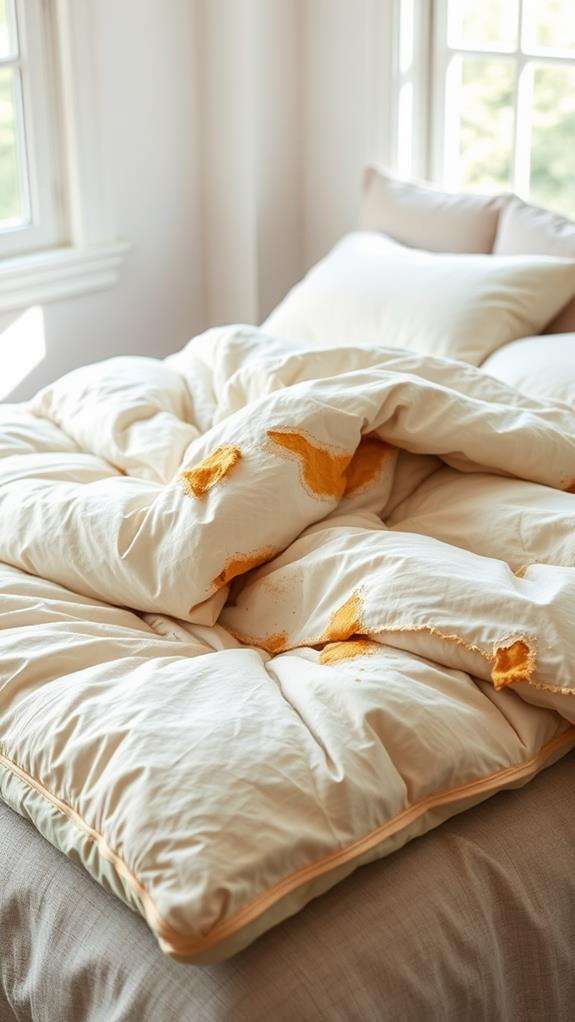
Your comforter's appearance and performance can tell you when it's time for a replacement, with visible signs like tears, stains, or frayed edges being clear indicators of wear. If you notice your comforter's filling has developed clumps or uneven distribution, it's lost its ability to provide consistent warmth throughout the night. When your once-fluffy comforter becomes limp and fails to bounce back after washing, you're likely dealing with broken-down insulation that can no longer keep you properly warm.
Visible Wear and Tear
Identifying visible wear and tear on your comforter is essential for maintaining a comfortable sleeping environment. When you're examining your comforter, you'll want to look for several key signs of wear that indicate it's time for a replacement. The most noticeable indicators include thinning fabric areas, color that's starting to fade, and fraying edges that have begun to unravel.
You'll also need to pay close attention to the comforter's filling distribution. If you notice that the filling has started to clump or shift unevenly within the compartments, it's a clear signal that your comforter is deteriorating. Watch for any signs of limpness, as this means your comforter isn't providing the insulation it should. Small holes or tears in the fabric might seem minor at first, but they'll typically worsen over time and compromise your comforter's effectiveness. When you spot filling material escaping through these openings, don't wait to replace your comforter – this is a definitive indication that it's reached the end of its useful life and needs to be replaced immediately.
Fill Distribution Problems
Fill distribution problems often reveal themselves through distinct patterns that make your comforter less effective at keeping you warm. When you notice uneven distribution of filling throughout your comforter, it's a clear signal that its internal structure is breaking down. While regular maintenance through shaking and fluffing can help prevent minor clumping, persistent fill distribution problems indicate it's time for a replacement.
You'll know your comforter needs replacing when you observe these tell-tale signs:
- Noticeable cold spots where filling has shifted away from certain areas
- Stubborn lumps that won't redistribute even after vigorous shaking
- Significant loss of loft, resulting in flat, ineffective insulation
- Visible leakage of filling material through seams or fabric
These issues directly impact your comforter's ability to provide consistent warmth and comfort. When filling starts to shift and cluster, it creates uneven insulation that compromises the comforter's primary function. Pay particular attention to areas where filling has completely migrated away, leaving thin spots that allow cold air to penetrate. If you're experiencing any of these problems consistently, it's time to start shopping for a replacement.
Loss of Warmth
One of the most reliable indicators that your comforter needs replacing is a noticeable decline in warmth during sleep. If you're finding yourself consistently cold at night, despite maintaining your usual room temperature, your comforter's insulation may be failing.
You'll likely notice that your once-fluffy comforter feels significantly flatter or limper than when you first purchased it. This loss of warmth often occurs when the fill material begins to break down, causing uneven distribution and cold spots throughout the bedding. When you find yourself regularly reaching for extra blankets or layering multiple covers to stay comfortable, it's likely time for a new comforter.
Pay attention to how often you wake up feeling chilly during the night. If you're consistently disturbing your sleep to adjust your bedding or add layers, your comforter has probably lost its insulating properties. Just as you should consider replacing pillows every few years, your comforter will need to be replaced when it no longer provides adequate warmth. Watch for these warning signs, particularly during colder months, as they're reliable indicators that your comforter has reached the end of its effective lifespan.
Proper Comforter Care and Maintenance
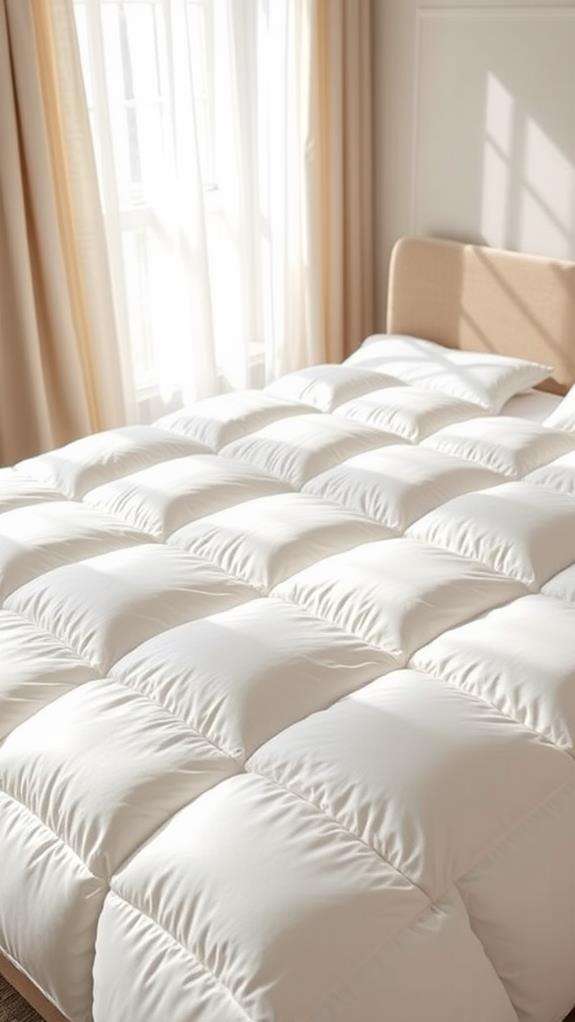
Taking proper care of your comforter is essential for maintaining its quality and extending its lifespan. To maintain cleanliness and guarantee your bedding stays in top condition, you'll need to wash your bedding every 3-6 months according to the manufacturer's instructions. Utilizing natural solutions like powerful whitening treatments can also enhance your comforter's appearance while being gentle on the fabric. Using a duvet cover isn't just about style—it's a practical way to protect your comforter from daily wear and tear, helping to prolong its lifespan.
Here's what proper comforter care looks like in practice:
- Store your comforter in a breathable cotton bag when it's not in use
- Air out your comforter monthly to maintain its loft and freshness
- Rotate your comforter seasonally to prevent uneven wear
- Follow care labels carefully when washing to prevent damage
Remember that consistent maintenance can considerably reduce how often you'll need to replace your bedding. By incorporating these care practices into your routine, you'll help preserve your comforter's insulating properties and structural integrity. Don't forget to check for signs of wear regularly, and always store your comforter in a cool, dry place to prevent moisture-related issues that could compromise its quality.
Best Materials for Long-Lasting Comforters
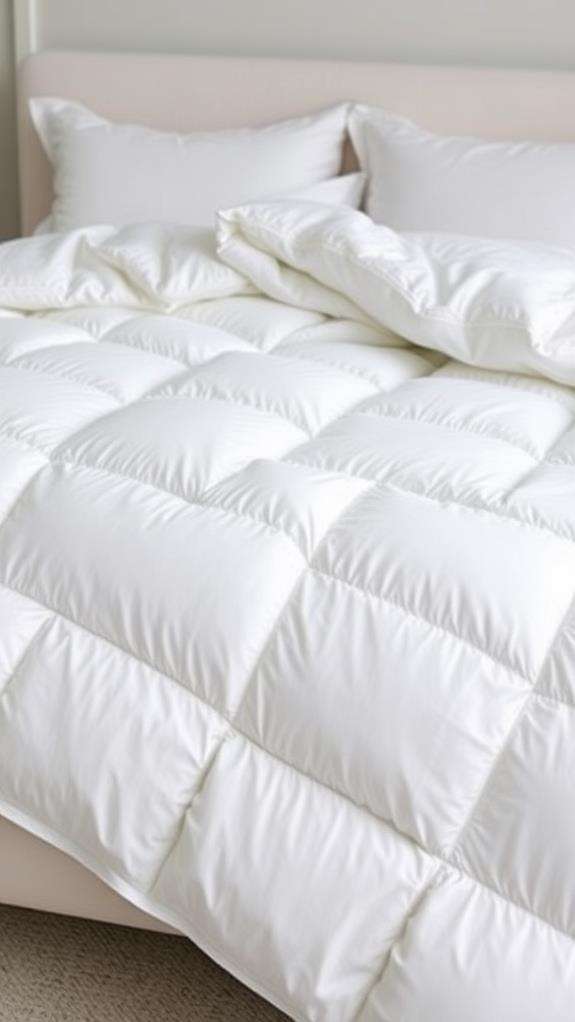
Materials make all the difference when choosing a comforter that'll stand the test of time. When you're investing in a new comforter, you'll want to focus on the best materials that offer superior durability and longevity, ensuring you get the most value for your money.
Down comforters are your premium choice if you're looking for exceptional longevity, as they can last up to 20 years with proper care. Their natural resilience and superior insulation properties make them a worthwhile investment, especially when paired with high-quality cotton or bamboo blend covers. You'll find that these natural materials provide excellent breathability while protecting the fill inside.
If you're considering synthetic materials, keep in mind that they typically offer a shorter lifespan of 5-10 years. While they're often more budget-friendly initially, you'll need to replace them more frequently than their down counterparts. To maximize the life of any comforter you choose, look for strong construction features like double-stitched seams and baffle boxes. The cover material should be tightly woven to prevent fill from escaping and resist wear from regular use.
Storage Tips to Extend Life
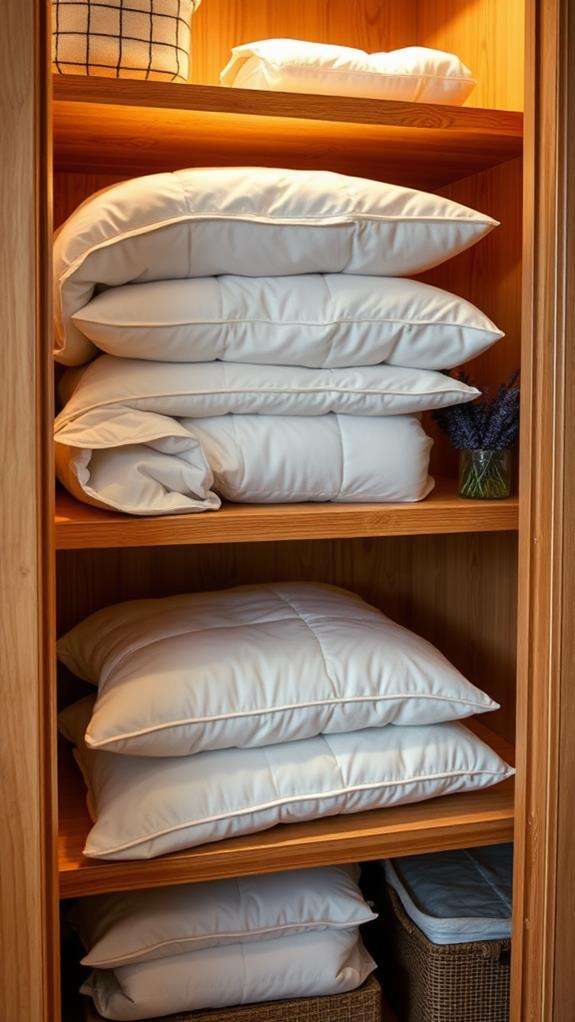
Even the highest quality comforters need proper storage to maintain their longevity. To prevent deterioration and extend your comforter's life span, you'll want to store it in a cool, dry environment that allows proper airflow. While it might seem convenient, don't reach for those plastic storage bins – they're actually your comforter's worst enemy, as they trap moisture and can lead to unwanted odors and fabric breakdown.
Instead, opt for breathable storage solutions that'll help maintain your comforter's quality:
- Use cotton storage bags or clean pillowcases that allow air circulation
- Place cedar blocks or lavender sachets nearby to prevent pest infestations
- Store in elevated locations away from basement floors or damp areas
- Keep away from direct sunlight to prevent fabric fading
Before you store your comforter, make certain it's completely clean and dry to prevent any stains from setting or mold from developing. Throughout the storage period, check on your comforter every few months – give it a good shake and re-fluff to help maintain its shape. This regular maintenance will guarantee your comforter stays in prime condition until you're ready to use it again.
Seasonal Impact on Comforter Durability

While your comforter's durability largely depends on its quality and care, seasonal changes play a crucial role in determining its lifespan. You'll notice that during colder months, your comforter faces increased stress from frequent use, body heat, and moisture retention, which can accelerate wear and tear.
| Season | Impact on Durability | Maintenance Needs |
|---|---|---|
| Winter | High wear and tear | Weekly airing out |
| Spring | Moderate humidity | Monthly cleaning |
| Summer | High humidity risk | Storage prep |
| Fall | Temperature fluctuation | Shift care |
To maintain freshness and extend your comforter's lifespan, you'll need to adjust your care routine seasonally. During humid summer months, your comforter requires more frequent washing, but be careful as excessive cleaning can compromise its durability. If you've invested in a natural fiber comforter, like down, you'll find it adapts better to seasonal changes compared to synthetic alternatives.
When shifting between seasons, make sure you're storing your comforter in breathable bags and avoiding extreme temperature variations. Regular airing out, especially during seasonal changes, helps combat moisture buildup that can degrade your comforter's quality over time.
Quality Vs Price Considerations
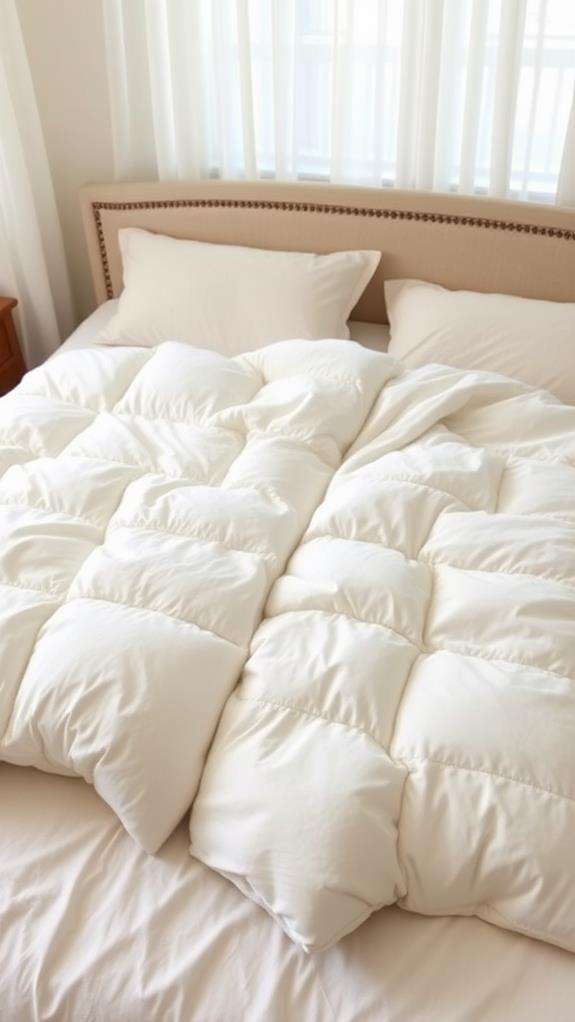
When you're comparing comforter prices, you'll find that investing in a high-quality option, though more expensive initially, can save you money over time since premium comforters often last 20-25 years compared to cheaper alternatives that need replacement every 5-10 years. Just like choosing kitchen appliances based on durability can lead to long-term savings, your choice between investing in quality materials like down or high-end synthetics versus opting for budget-friendly alternatives will directly impact both your comfort and your wallet, especially when considering the long-term cost per year of use. Quality kitchen appliances and superior construction features, such as double-stitched seams and high thread counts, make premium comforters a smart investment that pays off through extended durability and enhanced sleeping comfort, particularly when paired with proper maintenance routines.
Price Impact on Longevity
The price tag on your comforter often reveals more than just its cost – it's an indicator of its potential lifespan. When you invest in a higher-priced comforter, you're not just paying for luxury; you're securing a longer-lasting bedding solution that could serve you well for up to 25 years, compared to budget alternatives that might need replacement within 5 years.
Reflect on these key factors that link price to longevity:
- Premium materials like natural down offer superior durability and maintain their loft longer than synthetic alternatives
- Higher-quality construction techniques, including double-stitched seams and reinforced corners, prevent wear and tear
- Better fabric shells resist pilling and maintain their integrity through multiple washing cycles
- Superior fill power in expensive comforters guarantees better insulation retention over time
While the initial investment in a quality comforter might seem steep, it's important to evaluate the cost per year of use. A $300 comforter lasting 15 years costs you $20 annually, while replacing a $100 comforter every five years results in the same annual cost but with more hassle and waste. Your choice in price point today directly influences your comforter's longevity tomorrow.
Investment Vs Quick Fixes
Savvy shoppers often face an essential decision when selecting a new comforter: invest in lasting quality or opt for a quick, budget-friendly fix.
When you're considering your bedding investment, it's important to understand that quality comforters, particularly those made from premium materials like down or bamboo blends, can serve you well for 15 to 25 years. While you might initially balk at their higher price tags, these durable options actually prove more economical over time. You won't need to replace them nearly as frequently as their cheaper counterparts, which typically wear out within 5 to 10 years.
The math becomes clear when you break down the long-term costs. A high-quality comforter might cost more upfront, but when you divide that cost over its extended lifespan, you're likely spending less per year than you would with repeated purchases of lower-quality alternatives. In addition, premium comforters offer superior insulation and comfort, potentially improving your sleep quality. Instead of viewing your comforter purchase as a quick fix, consider it a long-term investment in both your comfort and financial well-being.
Material Quality Differences
Quality stands at the forefront of every comforter purchase decision, directly impacting both your wallet and sleep experience. When you're comparing different comforters, you'll notice considerable variations in material quality that directly affect their lifespan and performance. High-quality down comforters, while initially more expensive, can serve you well for 15 to 20 years, while synthetic alternatives typically need replacement within 5 to 10 years.
Understanding these material differences helps you make an informed decision:
- Down comforters offer superior insulation and durability, maintaining their loft and warmth through proper care
- Cotton blend shells provide excellent breathability and strength, extending your comforter's lifespan
- Synthetic materials, while budget-friendly, often show wear faster and may lose their insulating properties
- Construction details, such as box stitching and reinforced edges, considerably impact durability regardless of fill type
You'll find that investing in quality materials pays off through extended durability and improved comfort. The key lies in recognizing that superior materials, combined with proper maintenance, result in better value despite higher upfront costs. When selecting your next comforter, consider how material quality will affect its longevity and performance over time.
Environmental Factors Affecting Comforters

Various environmental factors play an essential role in determining how long your comforter will last. When you're living in a humid climate, you'll need to be particularly vigilant, as excess moisture can encourage mold and mildew growth within your bedding. Regular cleaning can help mitigate these issues, especially if you utilize proper techniques including how to wash silk sheets to refresh your comforter. Similarly, if your home is too dry, certain fill materials might break down more rapidly, shortening your comforter lifespan.
You'll want to pay attention to where you place your bed, as direct sunlight streaming through windows can gradually fade your comforter's colors and weaken its fabric. If you have pets sharing your bed, you're likely to notice accelerated wear and tear, along with increased accumulation of fur and dander that requires more frequent washing. The seasonal nature of your comforter use matters too – if you're using it year-round, you'll need to replace it sooner than if you're storing it during warmer months.
To maximize your comforter's durability, establish a regular maintenance routine that includes proper washing and storage practices. Follow the care label instructions carefully, and consider using a duvet cover to protect against environmental damage and extend your comforter's life expectancy.
Frequently Asked Questions
When Should You Throw Out a Comforter?
While your comforter might look perfectly fine on the surface, hidden wear could compromise its comfort. You'll know it's time to replace your comforter when you notice significant clumping of the filling, a limp appearance, or visible wear and tear. Down comforters can last 15-25 years with proper care, but down alternatives need replacement every 5-10 years. If your comforter's not keeping you warm anymore, it's likely time for a new one.
How Do You Know When You Need a New Comforter?
You'll know it's time for a new comforter when you notice several key signs. If your comforter's lost its fluffiness or has visible clumping of filling, it's no longer providing proper insulation. Watch for persistent unpleasant odors that remain after washing, as well as stubborn stains or discoloration that won't come out. If you're feeling consistently cold at night despite adequate bedding, your comforter's likely lost its warming effectiveness.
How Often Do You Really Need to Wash Your Comforter?
While you might feel tempted to wash your comforter only when it's visibly soiled or starting to smell like a forgotten gym bag, you'll want to launder it every three months. If you're using a duvet cover, you can stretch this to four months. However, if you've got allergies or pets sharing your bed, you should wash it more frequently – about every six to eight weeks. Don't forget to spot clean stains immediately.
How Long Do You Use a Comforter?
You can typically use a comforter for 15 to 25 years if you're maintaining it properly. If you've invested in a high-quality down comforter, you'll likely get up to 20 years of use, while down alternatives usually last 5 to 10 years. You'll know it's time for a replacement when you notice signs like clumping fill, a limp appearance, or filling that's leaking through the fabric.





